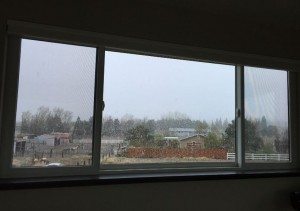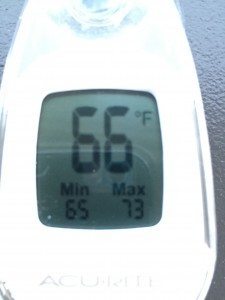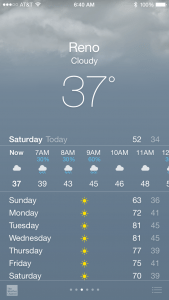
Life in the high desert, eastern front, of the Sierra Nevada Mountains is a crazy ride of temperature swings most of the year round. 30-40 degree differences from the early morning cold to mid-afternoon warmth are not uncommon. Since moving to our area in the late 70’s, those who know and love me had found me the easy target of jokes due to my layers of clothing, a blanket when sitting on the couch or at my desk, and the ever present microwavable heating bag, for about 10 months out of the average year! Although our previous home was innovative for the time it was built in 1992, using passive solar elements, whole house air circulation, and low-e high quality windows, it was not sustainable for a variety of reasons. 20 years ago, we didn’t understand the concept of sustainable home construction like we do now. We were thinking more about efficient use of heating and cooling in an altogether different way. The Blower Door test and HERS rating wasn’t even a glimmer in your sustainable daddy’s eye! There were no Energy Auditors or Appraisers thinking about getting their Sustainable Building certification. Most builders thought that it was better for a home to “breathe”, in order to prevent mold and mildew growth, rather than curtail the transfer of heat to cold to reduce energy consumption.


Many regular followers of Envirohaven have seen my occasional thermometer postings on our Facebook page. The photos help to document what the inside and outside temperatures were on the most extreme days and nights. These photos show what the temperatures were today. We turned the pellet stove on for about an hour this morning. Right now, at 9:30pm, the thermometer upstairs next to me reads 69 degrees, No other heat was on today. It was a mostly cloudy day, but the few hours of sun we had this afternoon kept us quite cozy inside. These thermometer readings, as well as our very low monthly utility and heating costs, make a very compelling argument for keeping a home sealed up tight to prevent air transfer. But those are only numbers on paper. How those numbers have translated to our real lives is quite remarkable.
Inside our sustainable Haven™ home, temperatures stay in the 60’s all winter long, day and night with very little augmentation from a heating source. In comparison, the thermostat in our old house had been kept in the low 70’s. Yet, I have not once pulled out the microwave heating bags!! I wear a light sweatshirt some evenings if I’m sitting at the computer or watching TV. I have never, all winter long, felt chilled!
Keeping the temperature in our home at this consistent temperature is quite simple and sustainable.
Here is how our utility costs have broken down for monthly maintenance for +/- 2000 sf. of temperature controlled space during our first 6 months of living in our Haven™, Oct-April:
- Electricity: well pump, back up water heater, house lights (all LED)= Less than $40/mo.
- Propane: Furnace, range, dryer = under 45 gallons
- Wood Pellets= Less than 50 bags used
When the outside temperatures are below zero and average daytime temperatures don’t rise above 40 degrees, or so, we get up in the morning to a thermometer reading in the low 60’s. We never turn on our furnace at night. We have insulated shades that would help to keep our warm air in, but the window frames have maximum insulation and we love waking to our 360 degree view. We feel a bit wasteful, but prefer not to put them down at night.
In order to maintain the temperature and keep our fuel usage so low, we have a very simple winter routine.
When we get up, we fire up the pellet stove (push the button on the side) for about an hour or two, until the inside room temperature downstairs reached the upper 60’s. On days when it’s very cloudy and stormy out and we’re home, we’ll keep the pellet stove on a bit longer. It feels cozy to see a fire going, but we don’t miss hauling bags of pellets from the store, to the garage, to the house, almost daily!
Our sustainable Haven™ home is a very quiet place to live. Not unlike a home heated by radiant underfloor or baseboard heat, we don’t have the noise of air movement in duct work all day and night long. After living here through the winter, we see that there would be no reason to incur the added expense of hydronic radiant heat.
If the sun comes out during the day, no matter what the outside temperatures, it will stay warm enough to not need the pellet stove in the evening. We don’t plan to use it tonight. Our insulated concrete floor helps to maintain the inside temperatures; radiating the warmth of the day back into the air at night when it’s cooler. Remember, heat seeks cold! That works to our advantage with the concrete floor.
If the inside temperature is hovering in the low 60’s in the evening, we turn on the pellet stove for a couple hours, or so, until the thermostat reads upper 60’s or 70 degree max. We do love hanging out in the living room on the couch with the fire going. About a half hour or so before we retire for the evening, we may turn on the fan to the furnace only (no heat). The house naturally convects the warm air upstairs remarkably well due to its shape, but the circulation from the fan gives the air movement a bit of a boost. When we go to bed, we shut everything down. That’s it! Simple, efficient, comfortable, and sustainable!
For those living off-grid, using less translates to a lot less hauling of fuel. Much more efficient and MUCH more sustainable!
Please help us share the joy of living sustainably by subscribing to these posts and sharing with those you care about.





You must be logged in to post a comment.